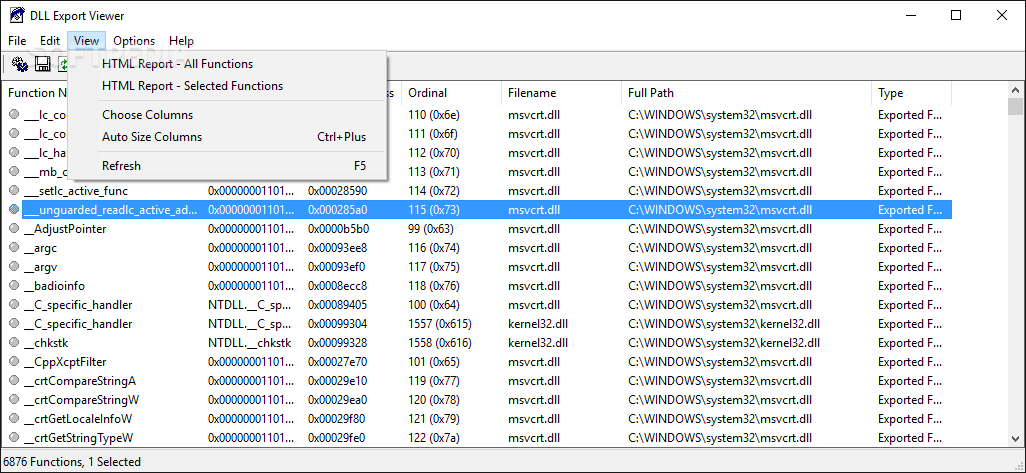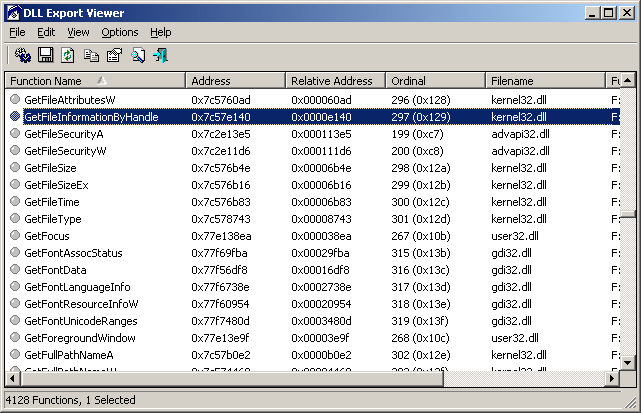Dependency Walker is a free utility that scans any 32-bit or 64-bit Windows module (exe, dll, ocx, sys, etc.) and builds a hierarchical tree diagram of all dependent modules. For each module found, it lists all the functions that are exported by that module, and which of those functions are actually being called by other modules. DLL Player is a software tool for exploring PE (Portable Executable) files (EXE, DLL). You view and edit DLL files on. Just edit/ view DLL files without any.
DLL (Dynamic Link Library) is a Windows file that is widely used by many different Microsoft Windows operating system related programs to store and execute additional functionalities that are highly essential to run the program. The DLL file found in a local drive of your personal computer might have been created by a single or multiple Windows program. Such files get dynamically linked with the respective program by running in the background only when the program was said to be opened by the user. If at all a DLL file has been found on your desktop, then there is no need to panic as it might be a Windows program trying to safely store codes. To check which program has saved the DLL file, you need to follow either one of the below-mentioned methods to open DLL file at ease.
Modifying or deleting the contents present within a DLL file might bound to create multiple errors in the program the file refers to in the first place. For this particular reason, the files that are saved as file extension DLL must be edited only if there is a need. Contrary to this, if at all an application has been trying to access its previously-stored DLL file that was found to be missing from its stored location; then either the application might crash randomly or not open up in the first place. You may have to find the DLL file or reinstall the particular program to create a new DLL file. If you have DMG file then you can use the DMG extractor to open DMG file easily. there are various applications available in windows that can be used to open DMg file.
Dll Reader And Editor
List of programs that can be used to open DLL file

- Download missing DLL files for free to fix DLL errors. If you want help to install DLL files, DLL‑files.com Client is the DLL fixer you need.
- EXE headers - analyze portable executable files (.exe,.dll,.drv,.sys,.etc) online and view basic header information and images / icons embedded into file. Featured stuff; Response header - view web server response headers. Learn, analyze and reduce HTTP header overhead, and as a result, increase actual payload size, to fit more data into.
- DLL Tool is a DLL file fixer that detects any missing DLL file and restores them.
- Microsoft Windows.
- Microsoft Visual FoxPro.
- 7-Zip.
- Resource Hacker.
- Microsoft Visual Studio.
- DLL-Files.com.
Open DLL files in Windows 7 by registering a new DLL type of file
If a DLL file copy is said to be present in an odd drive location in your PC, then you need to register it with the windows registry beforehand opening them.
- Open up Run command from the ‘Start’ menu or by pressing ‘Windows Key and R’ from the PC connected keyboard.
- Within the Run command, type ‘cmd’ and press the ‘OK’ button or the ‘Enter’ button in the keyboard.
- The command prompt shall load up.
- Alternatively, you can load the command prompt from the folder that has the DLL file stored in it by holding the ‘Shift’ button and right-clicking on any part of the window.
- A drop-down list shall load, from which select ‘Open command window here’.
- In the command prompt window, type ‘regsvr32 filename.dll’ and then press the ‘Enter’ button.
- The unknown DLL file has been registered to the Windows registry, and now you can safely open it using a decompiler program or Windows Visual Studio tool to find the exact program that has created this file with file extension DLL.
To safely remove the saved DLL file without damaging the Windows registry, you need to type regsvr32 u filename.dll within the command prompt window.
Open DLL files in Windows 7, 10 using Windows Visual Studio tool
- Click on the ‘Start’ Menu
- Within the ‘Search programs and files’ tab type Visual Studio and then press the ‘Enter’ button in the keyboard
- Visit the folder that contains the Visual Studio Command Prompt
- Double click on the icon that says ‘Developer Command Prompt’
- Once the command prompt loads up, you need to type ‘ILDASM.exe’ and then press Enter
- To open DLL file, you need to drag it using the connected mouse to this command prompt window
- You can also add the DLL file by navigating to the File menu and then clicking upon ‘New’ from the drop-down list
Now, glance through the files to find out the exact Windows program that has created the loaded DLL file.
Opening DLL file using Visual Studio Online
If your Windows running computer or laptop does not have Visual Studio installed, then you can make use of Visual Studio online to open DLL files any part of the day.

- Open a web browser that you have been constantly using to browse the internet.
- In the address bar, type https://online.visualstudio.com/login and then press the ‘Enter’ button in the keyboard.
- The Visual Studio Online page shall load up.
- You need to ‘Sign In’ using your existing Microsoft account or create one to upload and open DLL files.
- By clicking on the ‘Sign In’ button, a new pop-up shall load requesting you to enter a valid Microsoft account credentials.

Once you have logged in, you can upload the DLL file, read through the codes that were used to create them, and make sure to replace them back at the right place to avoid facing future Windows operating system-related errors.
Open DLL file using a decompiler program
To open dll file, download a decompiler program that can let you see through the source codes that were earlier used to create the file for a particular program. The main job of a decompiler program is to revert the codes into a readable mode. If at all you have tried opening the DLL file using Notepad that results in showcasing unreadable characters, then converting the code using a decompiler program shall benefit you more.
- dotPeek is a popular free decompiler program that you need to download and install at first to open DLL files at ease.
- Once the dotPeek or any other decompiler program has been installed to your Windows operating system, open it up.
- From the home screen window, click upon the ‘File’ menu and navigate to ‘Open’.
- A new pop-up window will appear asking you to choose the DLL file.
- After finding the respective DLL file, click upon the ‘Open’ button.
- Now, the Assembly Explorer window shall open up showcasing different nodes the DLL file has been saved with.
- You get the privilege to expand the nodes, browse through the sub-nodes and then select a particular node to see through the codes.
- If at all the node have codes attached to it, then the same shall appear on the right part of the decompiler program.
- Scroll through the showcased code to find out the program that has created such additional libraries.
Dll Reader Tool
DLL files are made up of modules or nodes that work together in taking forward the much-needed additional activities for a Windows program.
Exporting the code from a decompiler program to Visual Basic to open DLL file and to edit the resources:
If you are looking forward to editing, manipulating and re-building the DLL file, then you need to follow the upcoming step-wise guide as it is.
- Make a right-click upon the DLL file within the Assembly Explorer in the decompiler program’s window
- A new drop-down list shall load-up, from which you need to select upon ‘Export to Project’
- Wisely choose the export options
- You can even open the DLL file project immediately using Visual Studio or store it up and open at your convenience
- Once the DLL file project has been loaded into Visual Studio, you get to have complete control access to edit, rebuilt and save the DLL as per your need.
Dll Reader Free Download
The code that has been exported to the Visual Studio will be in C# language, even if the original DLL file was created in a different programming language.
Type of DLL filenames that can be opened using above-mentioned methods
Dll Reader For Windows 10
- Mfc42u.dll – This is an MFC (Microsoft Foundation Class) library file that is needed to run numerous Windows programs. If you are trying to open dll files in windows 7, download a decompiler program and register it with the Windows registry to avoid damaging the operating system in anyways.
- Mfc80u.dll – This is also an MFC library file used by Windows programs that are created using Visual C++ 2005. If this particular file is found to be missing, then you need to install the Redistributable Microsoft Visual C++ package at first.